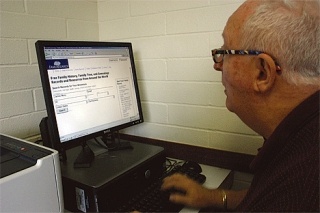Author Alex Haley spent ten years tracing his family tree for his novels, the most famous being, “Roots: The Saga of an American Family.”
He later said, “In all of us there is a hunger, marrow deep, to know our heritage … without this enriching knowledge, there is a hollow yearning no matter what our attainment in life.”
Today, partly with the urging of Haley, the study of genealogy is a national and hugely popular hobby. The Internet has only eased the process with thousands named “Smith” and “Jones” able to compare family trees and post photos. Ancestry.com, Genealogy.com, Mytrees.com each have basic family records, for a fee.
But sifting through fact and fiction sometimes requires a specialist, and free access to the largest genealogy library in the world.
The Oak Harbor Church of Jesus Christ of Latter-Day Saints recently opened a Family History Genealogical Center. The center is for church members, but it’s also open to the public free of charge.
The church has done extensive mapping of family trees by combining records from other Web sites, census records, searching through old passenger lists and documenting christenings, among other research techniques. At the church headquarters in Salt Lake City, Utah, millions of rolls of microfilm are kept in storage.
“If you want to look at microfilm of your family’s 1720 British parish, we can order it. The price is $5.92 for 60 days, then it is sent back,” said Terry Beatty, director of the Oak Harbor center.
The center has three computers with DSL lines and microfilm and microfiche viewers. People are asked to bring as much information as they know, such as parents’ names, birth dates, grandparents, where people were married and where family members died.
To show what can be accomplished, Beatty made a “pedigree chart” that traces his line back to 1621. Some people, he said, have chased their genealogy back to the one-digit B.C.
To begin the search (which can also be done from home) people will visit familysearch.org. There are areas to type in names, life events, years and countries. In this writer’s, I used Fred Burlingame, my grandpa. Based on a Social Security index, they found five matches in Pennsylvania. Sometimes the searches bring up images or documents, Beatty said, and in my case, a pedigree chart.
Based on merging last names and family lines, it’s possible to click through names for hours, with occasional backtracking when you reach dead ends. But even adhering to your own last name can churn up some detailed information.
“Ancestors can become more real when you learn about them, such as what lead them to emigrate or what jobs they had,” Beatty said.
While most of the information from familysearch.org is centered on names, the church offers resources not found online. They have CD-ROM programs such as Vital Records Index of North America, which contains marriage records. Some of their literature offers guides for searching through passenger lists, to track down relatives who emigrated to America. For example, one guide shows you how to read old, gothic script handwriting from German passenger lists.
Tracing genealogy is very important to church members, Beatty said.
“People can take the names of dead ancestors to the temple and do sacred work for them,” he said.
A more advanced genealogy Web site, “The New Family Search,” is for church members only, but may be open to the public soon. In the meantime, specialists at the church can assist with information-gathering and make hard copies or people can download documents with a flash drive. Beatty said he’s in the process of buying a microfilm machine that makes copies.
The Family History Genealogical Center is open Tuesday, Wednesday and Thursday from 6:30 p.m. to 9:30 p.m., or by appointment. The church is located at 201 NE Oleary St. Call Terry Beatty at 675-9739 for more information.


